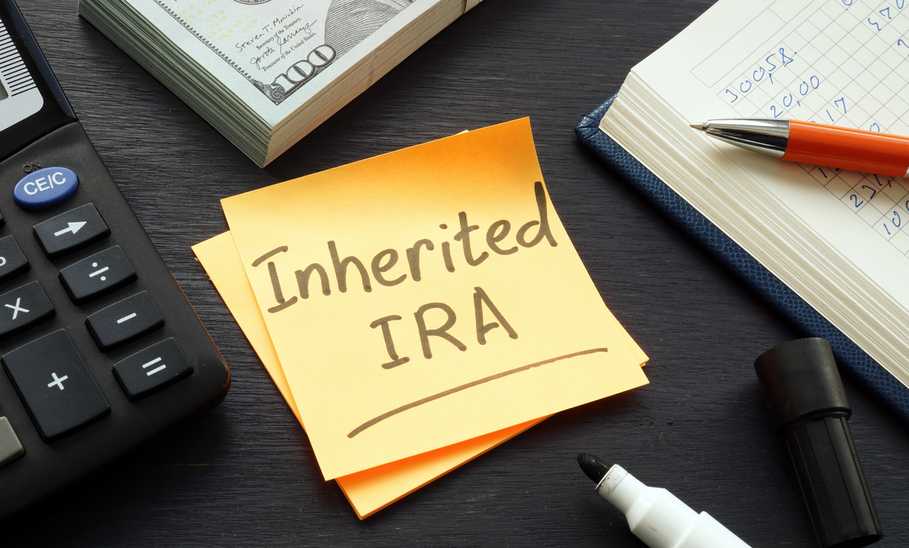- You choose the broker or trustee
- Wide investment selection
- Favorable Roth IRA treatment
- Option for spouses to open inherited IRA
Inherited IRA: All You Need To Know

Our evaluations and opinions are not influenced by our advertising relationships, but we may earn a commission from our partners’ links. This content is created by TIME Stamped, under TIME’s direction and produced in accordance with TIME’s editorial guidelines and overseen by TIME’s editorial staff. Learn more about it.
An inherited IRA is an IRA you open to receive funds from a tax-sheltered retirement plan of a deceased loved one. The funds transferred into the account can come from an employer-sponsored retirement plan, such as a 401(k) or an IRA owned by the deceased.
Knowing how to handle an inherited IRA is important because if you make a mistake, you face serious tax consequences and penalties. Unfortunately, the IRS is not especially forgiving of such mistakes.
When they die, most people leave an estate behind, which must be distributed to their heirs and beneficiaries. This includes the distribution of assets such as bank deposits, investment accounts, real estate, business interests, and personal property.
But it can also include retirement assets. Because those assets are tax-sheltered, distributing the funds from retirement plans requires special handling. That’s where inherited IRAs come into the picture.
An inherited IRA is created upon the death of an individual who owns an IRA (traditional, Roth, SIMPLE, or SEP), 401(k), or other tax-sheltered retirement plan. Once those funds are distributed from the respective plans, they are moved into an IRA account in the beneficiary's name.
In most respects, inherited IRAs work the same as other IRAs, whether traditional or Roth. However, because the tax deferral occurred during the decedent's life, tax law requires the distribution of funds from inherited IRA accounts within certain time frames.
While the regulations permit immediate distribution of funds from an inherited IRA, you can also spread distributions over several years, minimizing the tax consequences. Extended distributions are particularly beneficial when the inherited plan balance is large and can move the beneficiary into a higher tax bracket.
The table below highlights the main pros and cons of inherited IRAs:
Until 2019, spouses, children, grandchildren, and other non-spouse beneficiaries could stretch distributions from inherited IRAs across their life expectancies. That means a person inheriting a retirement account at age 40 may have been able to spread distributions over another 40 to 45 years. That distribution allowance minimized the ability of the IRS to collect income tax on the inherited funds.
Congress changed the distribution schedule with the SECURE Act of 2019, requiring distributions to take place over not more than 10 years for most beneficiaries. However, exceptions remain for beneficiaries who are minors, disabled or chronically ill, or no more than 10 years younger than the deceased owner of the inherited IRA.
Even with the change, the ability to distribute withdrawals over 10 years can substantially lower your income tax liability.
“The SECURE Act, which was passed in December 2019, made several changes to the rules on inherited IRAs,” explains Andy Krafft, CPA and CFP at Luminary Wealth. “One of the important rules to remember when inheriting an IRA from a parent is the 10-year rule, which states that the account has to be completely distributed by the end of the 10th year after the original owner’s death.
This 10-year rule effectively replaces the 5-year rule for many beneficiaries but doesn't mandate annual distributions. The entire balance just has to be taken out by the end of the 10th year.”
The SECURE Act also ordered that under the 10-year rule, if the plan owner dies after RMDs begin, annual distributions must be paid to the beneficiary during the first nine years, based on the life expectancy of the beneficiary.
This change was heavily criticized, so the IRS made the decision to waive the 2021, 2022, and 2023 annual RMDs for certain beneficiaries.
This RMD waiver has now been advanced to 2024.
Update: IRS Notice 2024-35 waives the 2024 annual RMD for beneficiaries who would otherwise have had to make a withdrawal under the 10-year rule. In other words, if you are a non-eligible designated beneficiary and you inherited an IRA after 2019, you no longer must make an annual RMD prior to 2025.
The entire plan must still be paid out completely in the 10th year, but beneficiaries can defer distributions to later years if they wish. However, back-loading RMDs to the end of the period could result in severe tax implications if it increases your income substantially in a given year. If you’re unsure how to spread out your distributions, make sure you speak with an accountant or other tax professional.
One of the key advantages of an inherited IRA is that you can choose where you hold the money. That’s true whether the account inherited is an IRA or an employer-sponsored plan.
For example, you can open a self-directed investment account if you feel confident in your investment abilities. J.P. Morgan Self-Directed Investing offers self-directed IRAs where you can invest commission-free in individual stocks, options, mutual funds, and exchange-traded funds (ETFs).
INVESTMENT AND INSURANCE PRODUCTS ARE: NOT A DEPOSIT • NOT FDIC INSURED • NO BANK GUARANTEE • MAY LOSE VALUE
You can either move the entire balance to a self-directed account or move part of it into a professionally managed account. That’s easily done through investing services, such as Empower. Either platform can provide complete investment management, including portfolio selection. They’ll start with determining your investment risk tolerance, time horizon, and investment objectives. From there, they’ll construct a portfolio with the proper mix of stocks and bonds for your investor profile.
The fact that you can open an inherited IRA account just about anywhere you like also means you have plenty of investment options. The IRS-prohibited retirement investment list is notoriously short, making it possible to invest in asset classes you may not have considered in the past.
For example, RealtyMogul enables you to invest in commercial real estate, choosing either private deals in individual properties or through private real estate investment trusts (REITs). REITs are like mutual funds, except they hold a portfolio of commercial property investments, such as apartment buildings, office buildings, and retail space.
You can set up an inherited IRA account through RealtyMogul using a special IRA type known as a self-directed IRA (SDIRA), which they will help you set up.
If you are inheriting an IRA or an employer-sponsored retirement plan from your deceased spouse, there are plenty of advantages. First among them is that you will have more options for taking distributions, resulting in a lower tax liability. We will cover those benefits and tax savings below.
Inherited Roth IRAs must be distributed in the same manner as traditional IRAs, though the tax benefits of a Roth IRA still apply.
UnderRoth IRA rules, contributions withdrawn are tax and penalty-free regardless of when they are taken. However, the withdrawal of investment earnings is subject to ordinary income tax if it is taken before the original plan owner is 59 ½ and has not had a Roth plan for at least five years.
While Roth IRAs are exempt from RMDs for the original plan owner, they can apply with inherited Roth IRAs.
As the original owner of an IRA, your account is protected from creditors’ claims in most states, though not as frequently with Roth IRAs. But that situation changes completely with an inherited IRA.
“IRAs or retirement accounts are protected from lawsuits and creditors,” explains Patrick Simasko, Elder law attorney and financial advisor at Simasko Law. “Beneficiary IRAs no longer have those protections, as a previous Supreme Court decision stripped them. This could be an issue if your beneficiary is in bankruptcy or has pending lawsuits.”
As you read this article and become aware of the many different rules, exceptions, and special considerations, you may decide that it is important to engage the services of a CPA or other qualified tax professional throughout the years the inherited IRA exists.
You should also consult a tax professional when the need for an inherited IRA becomes apparent. For example, if you take the full distribution of inherited retirement assets in the year received, you may be looking at an enormous tax bill. A qualified tax professional can help you to minimize those taxes.
The rules for inherited IRAs depend on whether you are the spouse or non-spouse of the decedent.
If the original owner of the retirement account dies before RMDs kick in, the spouse can take the distributions in one of three ways:
Alternatively, a spouse can do a rollover to his or her own IRA account, avoiding the need for distributions until he or she reaches the age for RMDs.
If the decedent was subject to RMDs at the time of death, the spouse is required to take distributions based on his or her own life expectancy or roll over the account balance into his or her own IRA. The 10-year rule does not apply.
Non-spouse refers to any beneficiary who does not qualify under tax rules for a spouse. As such, the only option is to follow the 10-year rule and pay the taxes as distributions are received.
“Inheriting an IRA from a parent is both a financial boost and a passing of the torch,” recommends Jeff Rose, Certified Financial Planner and founder of the website Good Financial Cents. “You have a few choices to make, including possibly moving assets to an inherited IRA account to enjoy some tax benefits. It's a chance to grow your parent's legacy while shaping your financial future, blending respect for their wishes with your own financial savvy. It's a big step, but one that can pave the way for financial stability and growth.”
The tax rules for spouses extend to minor children of the deceased, chronically ill or disabled beneficiaries, or individuals who are not more than 10 years younger than the original plan owner. However, these beneficiaries—referred to as eligible designated beneficiaries—do not have the option to do a rollover into their own IRA accounts.
The five-year rule for inherited IRAs applies to plans where the account holder's death occurs before 2020. Though it can be used by spouses, it was designed mainly for non-spouse beneficiaries.
The five-year rule is similar to the 10-year rule, except that it requires distributions to be made within five years of the original account owner's death. If elected, the beneficiary could have the option to take distributions at any interval as long as the plan is completely distributed by the fifth year after the original owner’s death.
However, the five-year rule was one of two options prior to 2020. The other was for the non-spouse beneficiary to spread distributions over their remaining life expectancy.
“The only situation where the 5-year rule still applies is when the beneficiary is a charity, a trust, or the owner’s estate,” explains Luminary Wealth’s Andy Krafft. “In that situation, the account must be distributed by the end of the fifth year following the original owner’s death.”
Funds distributed from an inherited IRA must be included in the beneficiary’s income tax return for that year and are subject to ordinary income tax. Since those distributions can take place over as many as 10 years, a good strategy is to make higher withdrawals in the years when the beneficiary has a lower income and thus a lower tax liability.
Conversely, smaller distributions can be taken in the years when income is high.
If the original plan owner was over 72 years of age and required to take an RMD in the year of death—but didn’t—the beneficiary must take the RMD and include it on his or her income tax return for that year.
TIME Stamp: Make sure you understand how inherited IRAs work
Even though federal taxes on estates apply only to those valued at $12.92 million or more, taxes may be a factor in inherited retirement assets. Because retirement plans have tax benefits, they’re subject to special tax rules, even if other estate assets are not. That’s why you need to know what an inherited IRA is, how it’s taxed, and how you can minimize that cost. Hiring a tax professional to guide you through the process can be a good idea.
Eligible designated beneficiaries, which include minor children of the decedent, chronically ill or disabled beneficiaries, or individuals who are not more than 10 years younger than the original plan owner, have three options with an inherited IRA:
Other children of the deceased must use the 10-year rule.
A traditional IRA is one you set up as the original owner. An inherited IRA is one you set up when you receive funds from the retirement plan of a deceased person. Though it works much the same as a traditional IRA, it does come with the requirement to distribute funds within specific time limits.
Just as with a traditional IRA, there are ways to minimize taxes on an inherited IRA but not to eliminate them completely. For example, by spreading distributions over 10 years, the overall tax liability will be much lower than it would be if you took a lump sum distribution upon receipt of the inherited plan funds.
The most significant exception is when the inherited IRA is received from a deceased spouse. If the surviving spouse opts to roll over the plan balance into his or her own IRA account, taxes will continue deferred until distributions are made from the spouse’s plan.
Once again, it's a good idea to consult a tax professional to determine the best way to minimize the tax impact of inherited IRA distributions.
The information presented here is created by TIME Stamped and overseen by TIME editorial staff. To learn more, see our About Us page.






